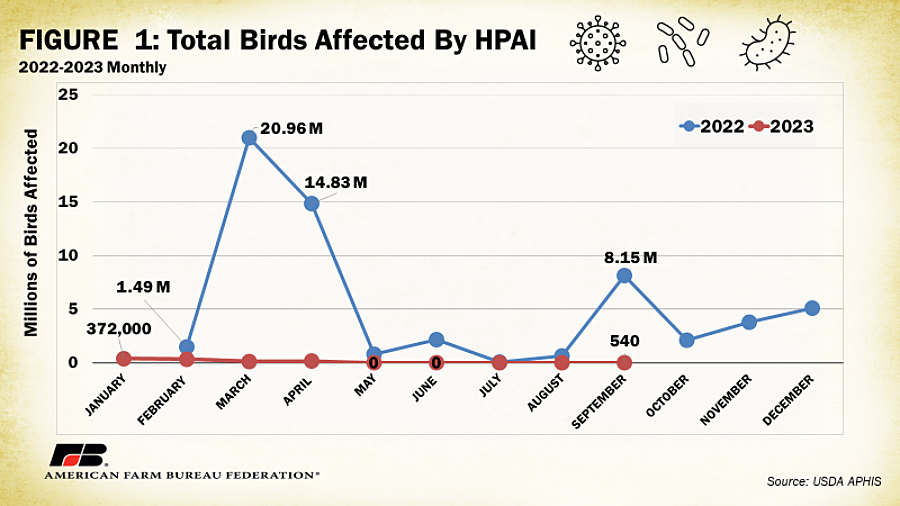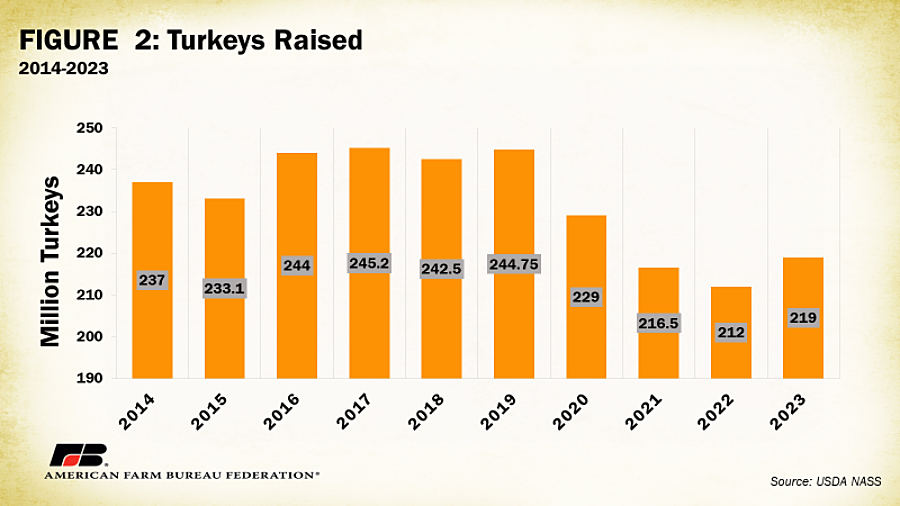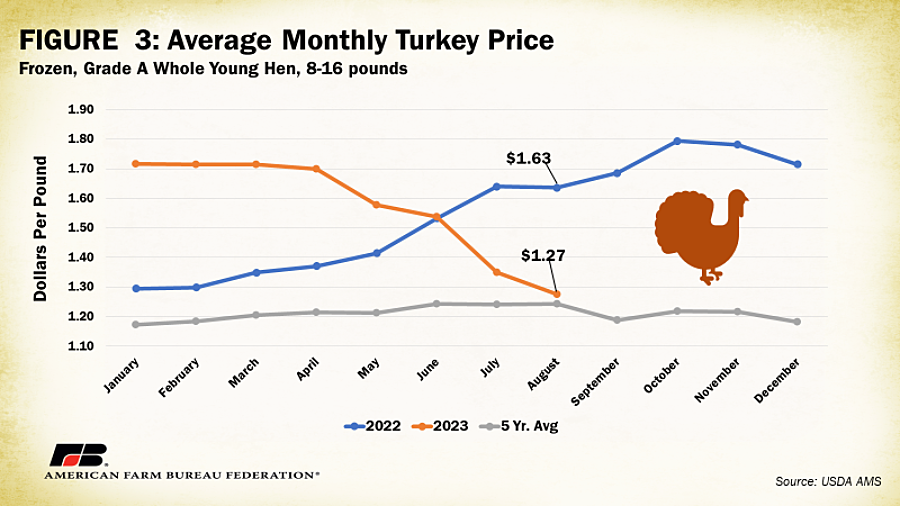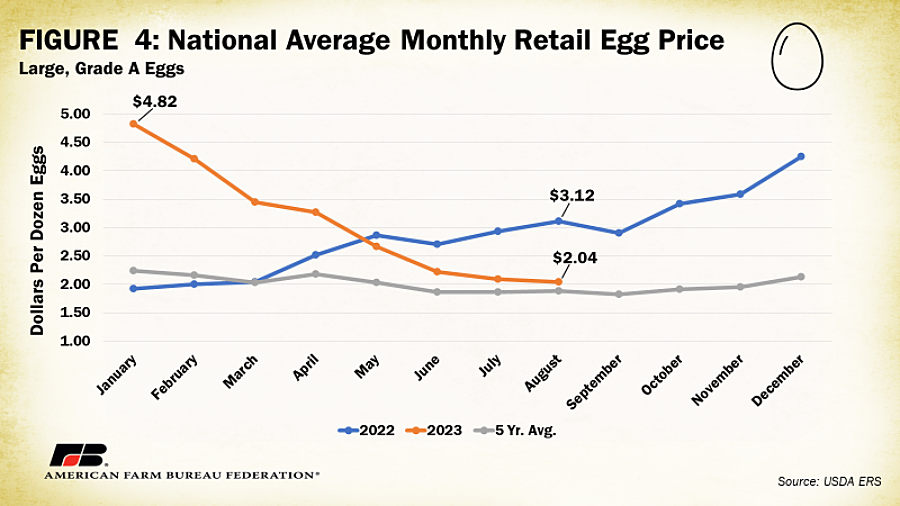By Bernt Nelson, Economist American Farm Bureau
Highly Pathogenic Avian Influenza (HPAI) has had a long hold on poultry and egg farmers in the United States. The H5N1 outbreak that began in January 2022 spanned almost 19 months with over 800 confirmed detections affecting nearly 59 million birds in commercial and backyard flocks. The resulting supply concerns and record turkey and egg prices during the 2022 holiday season caused problems for both consumers and farmers. With economic concerns still looming, consumers are wondering if Thanksgiving dinner will cost as much as last year. As many trees lose their leaves and we head toward the holidays, this Market Intel evaluates how the H5N1 avian influenza virus might affect prices this year.
HPAI
The status of HPAI is much different now than it was just a year ago. Migratory birds are a major vector of this virus, which naturally makes spring and fall migration high risk times (Figure 1). Detections from the current outbreak peaked during March 2022 with 20.96 million birds affected before gradually falling to just 540 birds in September 2023. This can be compared to 8.15 million birds affected in September 2022. June marked the first month with no detections since the outbreak began in February 2022.

Will Supplies and Prices be More Stable in 2023?
Supplies
Turkey supplies have recovered since the HPAI outbreak began. Due to the time it takes for poults placed on feed to be ready for market (about 14 weeks) poults must be placed on feed in July in order to be ready to market by Thanksgiving. According to USDA’s September 2023 Livestock, Dairy, and Poultry Outlook, July 2023 turkey production was 432.3 million pounds. This is 9.7% above July 2022, but still about 6% below pre-2022 HPAI outbreak levels, with 457.9 million pounds produced in July 2021. Much of the increase in production is attributed to live weights (the weight of a market ready bird) rising 3.8% above last year and higher processing numbers.
USDA’s Turkey Hatchery report, released monthly, indicates there were 26.8 million eggs in incubators on Aug. 1, up 1% from 2022. Poults (young turkeys) hatched during July were up slightly from 2022 at 22.5. Net placements of poults on feed in July were 21.9 million, down slightly from last year. May and June placements of poults on feed were well above average and make up for lower placements in July.
USDA’s annual Turkeys Raised report estimates that 219 million turkeys were raised in 2023, an increase of 4% from 2022 and 1% above pre-HPAI outbreak levels in 2021 (Figure 2). This increase in the number of turkeys raised along with strong placements of poults on feed in May and June is a good indication of lower consumer prices ahead of Thanksgiving.

Prices and Demand
Turkey prices gave consumers quite a shock in 2022. Driven largely by inflation and the effects of HPAI, prices reached a record $1.72 per pound for an 8–16-pound, frozen, Grade A, whole young hen, 20% higher than the previous year. These higher prices, caused by HPAI induced supply depletion, led to lower demand, with USDA estimating a decrease per capita demand of 2% in 2022, dipping from 14.9 lbs. per person to 14.6 pounds per person.
Average turkey prices in 2023 have fallen due to growth in production. The average price for the 8–16-pound turkey typically served for Thanksgiving was $1.27 per pound in August 2023, 22% lower than August 2022 (Figure 3). Some of the more specialized products have come down even more since last year. Boneless, skinless, tom turkey breasts, for example, have declined by 61% from the near record $6.65 per pound to $2.59 per pound in August 2023. The September 2023 USDA World Agricultural Supply and Demand Estimates report forecasts per capita demand for turkey to increase by 6% to 15.5 pounds per person in 2023 in response to lower prices.

Eggs
Egg production began a downhill slide due to HPAI in March 2022 that lasted 12 months with the first monthly increase in production occurring in April 2023. During this time, the effects of HPAI combined with inflation rates to send egg prices skyrocketing to record levels. (Figure 3).
USDA’s September Chicken and Egg report estimates total egg production was 9.38 billion eggs, up 2% from September 2022. There were 386 million total layers in the United States on Sept. 1, which is 3% greater than September 2022. This represents a recovery in the egg sector from last year’s HPAI outbreak. USDA states in the previously referenced September outlook that egg production for the second half of the year is expected to slow due to stagnant flock growth. This brings the projection for 2023 egg production to 7.885 billion dozen eggs, up 1.3% from 2022.
Demand/Prices
USDA’s Agricultural Marketing Service describes egg demand as “fairly good” in the Sept. 25 Egg Market News report, with regional wholesale prices for large shell eggs gently falling 10-35 cents with most prices between $1.19-$1.23 per dozen. USDA’s Economic Research Service estimates the national average retail price for shell eggs was $2.04 per dozen in August 2023, down 30% from $3.11 in August 2023. This is nearly 60% lower than the record average price of $4.82 set in January 2023 (Figure 4). Retail egg prices have come down a great deal from 2022 but the lower forecasted production for the second half of 2023 may cause a slight increase in egg prices.

Will there be enough turkey to go around for Thanksgiving?
Farmers and consumers alike should receive some turkey price relief for Thanksgiving. With very few HPAI detections, turkey and poultry supplies have recovered over the last year. This means there is plenty of turkey – and the lower prices that come with strong supplies – to go around for Thanksgiving. Consumers can get full details about turkey prices and more on Nov. 15 when the American Farm Bureau Federation releases the results of its annual cost of Thanksgiving dinner survey!